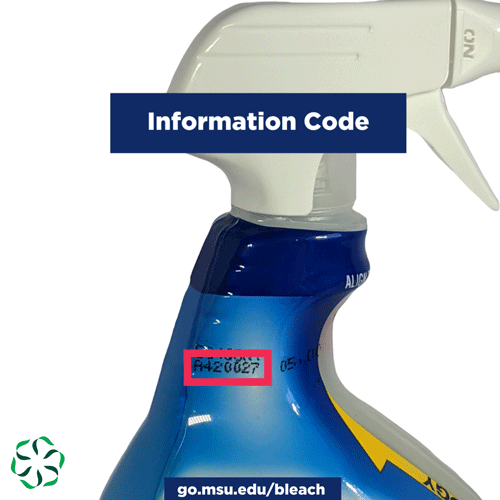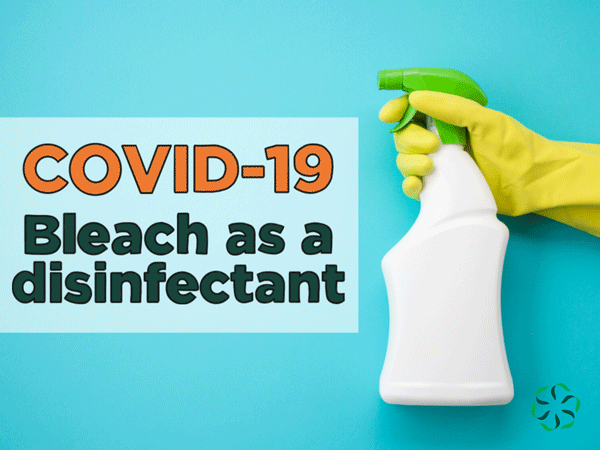In this post, we explain how you can use liquid household bleach to disinfect hard surfaces.
As we work together to combat the novel coronavirus that causes the disease commonly known as COVID-19, it’s essential to know how to create and use effective cleaning solutions. In this post, we explain how you can use liquid household bleach to disinfect hard surfaces.
What is household bleach?
Liquid household bleach is a chemical used frequently in laundering white clothing and disinfecting hard surfaces.
The active ingredient in liquid household bleach is a sodium hypochlorite solution at 2–10%.
Will bleach kill the coronavirus?
The Centers for Diseases Control and Prevention (CDC) and the World Health Organization recommend (1,2) using a bleach solution as one way to disinfect areas contaminated with the novel coronavirus.
There are other cleaning solutions available, including sprays, wipes, and more that can help disinfect areas exposed to the novel coronavirus.
What do I need to know about bleach?
Bleach has an expiration date and loses efficacy fairly quickly if not stored properly (1,2,3):
- Bleach expires 1 year from production.
- Bleach can start to lose potency quickly after opening if not stored correctly.
- Homemade cleaning solutions made with bleach should be remade after 24 hours.
Will expired, or old bleach still disinfect surfaces?
No, bleach loses efficacy with time and exposure to heat and light. So, after one year unopened on a shelf, if stored incorrectly in direct sunlight, or at a temperature above 77ºF, it begins to degrade and continues to deteriorate.
Once the product loses potency, it can no longer disinfect properly, and you need to dispose of it properly by diluting the remaining bleach with a large amount of water before it pouring into a sink drain (1,2).
How do I know if my bleach has expired?
On most bottles of bleach, there will be a 7 digit code printed on the bottle. This code contains the information you need to calculate the expiration date.
Let’s take the code E619337. We need to break this code into 3 parts, starting from left to right.
 The first two characters E6, tell us the facility the company manufactured the bleach.
The first two characters E6, tell us the facility the company manufactured the bleach.
The second number 19, tells us the year the company manufactured the bleach.
The last number 337, tell us the day of the year the company manufactured the bleach.
So, code E619337 tells us this bottle of bleach was manufactured at facility E6 in 2019 on the 337 day of the year, which is December 3.
This bottle of bleach expires one year from December 3, 2019, so it needs to be used or disposed of by December 2, 2020.
A product code A420027 tells us the product was manufactured at facility A4 in 2020 on the 27 day of the year, which is January 27.
 This product expires one year from January 27, 2020, so it needs to be used or disposed of by January 26, 2021.
This product expires one year from January 27, 2020, so it needs to be used or disposed of by January 26, 2021.
You can figure out the month and day by using this chart. Make sure to adjust the calendar for the year.
How do I disinfect hard surfaces in my home with a bleach solution?
Before disinfecting a surface, you should clean the area of any superficial dirt or grim.
Using the recipe recommended from the CDC and the WHO you will need:
- liquid bleach containing 2%-10% sodium hypochlorite active ingredient
- gloves
- cool tap water
- measuring devices including cup and teaspoon
- a container such as a bowl or a spray bottle
Follow the manufacturer’s disinfecting directions, or you can follow the recipes below based on the CDC’s recommendation** and the percentage of sodium hypochlorite.
Recipes based* on the percentage of sodium hypochlorite found in your liquid bleach to prepare a 0.12% sodium hypochlorite solution for Imperial units:
| Liquid Bleach Type | Amount of Bleach | Amount of Cool Tap Water |
| 2% Sodium Hypochlorite Active Ingredient | 3 teaspoons | 1 cup |
| 3% Sodium Hypochlorite Active Ingredient | 2 teaspoons | 1 cup |
| 4% Sodium Hypochlorite Active Ingredient | 1 1/2 teaspoons | 1 cup |
| 5% Sodium Hypochlorite Active Ingredient | 1 1/4 teaspoons | 1 cup |
| 6-7% Sodium Hypochlorite Active Ingredient | 1 teaspoon | 1 cup |
| 8-10% Sodium Hypochlorite Active Ingredient | 3/4 teaspoon | 1 cup |
Recipes based* on the percentage of sodium hypochlorite found in your liquid bleach to prepare a 0.12% sodium hypochlorite solution for International System units:
| Liquid Bleach Type | Amount of Bleach | Amount of Cool Tap Water |
| 2% Sodium Hypochlorite Active Ingredient | 15 mL | 240 mL |
| 3% Sodium Hypochlorite Active Ingredient | 10 mL | 240 mL |
| 4% Sodium Hypochlorite Active Ingredient | 7.5 mL | 240 mL |
| 5% Sodium Hypochlorite Active Ingredient | 6 mL | 240 mL |
| 6% Sodium Hypochlorite Active Ingredient | 5 mL | 240 mL |
| 7% Sodium Hypochlorite Active Ingredient | 4.5 mL | 240 mL |
| 8% Sodium Hypochlorite Active Ingredient | 3.75 mL | 240 mL |
| 9% Sodium Hypochlorite Active Ingredient | 3.5 mL | 240 mL |
| 10% Sodium Hypochlorite Active Ingredient | 3 mL | 240 mL |
Step one
Wearing the gloves, carefully measure the bleach and add it to the water solution.
Step two
Wearing the gloves, apply the solution to the hard surface, such as doorknobs or non-porous countertop.
Step three
To properly disinfect, the solution needs to be in contact with the surface for at least 5 minutes.**
Step four
Discard the solution by adding water and pouring it down a sink drain after 24 hours as it can lose potency quickly.
Learn how to make an effective bleach solution with this video.
Should I make a stronger bleach solution to kill the novel coronavirus?
No, it’s safest to follow the recommendations outlined on the bottle or by the CDC, more bleach in the solution can be corrosive and can potentially damage skin and eyes.
Do I need to take precautions when using bleach?
Yes, bleach can be corrosive and cause harm to the skin, eyes, and lungs. Always use bleach in a well-ventilated area and to wear gloves when handling the product or solution.
Never consume bleach or bleach products.
Make sure to read the label and follow all safety and first aid protocols outlined on the bleach bottle.
Never mix bleach with any product containing ammonia or acids (such as toilet bowl cleaners, rust removers, etc.) as it’s dangerous.
The good news.
This cleaning solution will disinfect surfaces from more than just the novel coronavirus.
Cleaning regularly can help prevent the flu, food born illness, and more which can in turn help decrease other infections which can lessen the burden on our healthcare systems.
*The table is designed to make a 0.12% sodium hypochlorite bleach solution based on CDC recommended 1:48 dilution of 6% sodium hypochlorite bleach (1,2)
**Prior to March 26, 2020, the CDC recommended a 5 minute contact time for their bleach disinfecting solution recipe intended to disinfect areas contaminated with the novel coronavirus. This recommendation was changed on March 26 and the contact time now states, “at least 1 minute.”
However, when we reviewed the contact time recommendations for CDC recommended products containing sodium hypochlorite on the EPA website we found great variability on the contact time, with sodium hypochlorite products recommending 1, 3, 5, or up to 10 minutes for disinfection.
Additionally, WHO published recommendations around the prevention and control of epidemic- and pandemic-prone acute respiratory infections suggest an approximate 5-minute contact time for a bleach solution with the above potency.
Taking all of this into consideration, we maintain the 5-minute recommendation as it is the most conservative approach.

